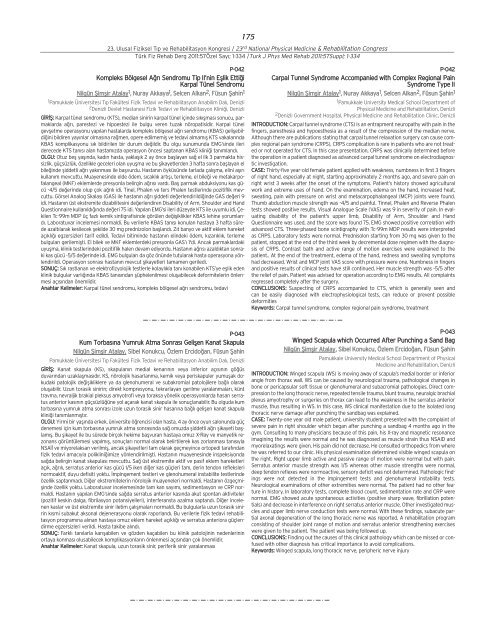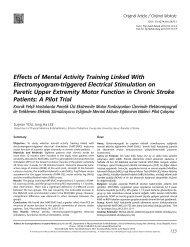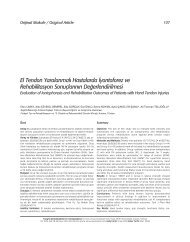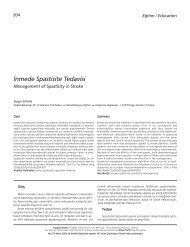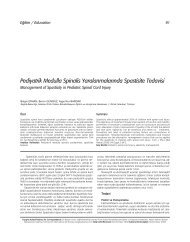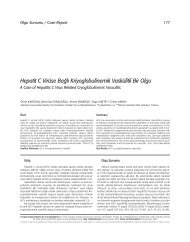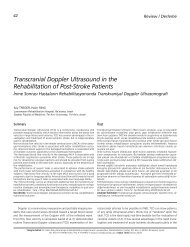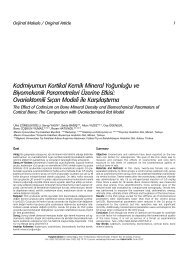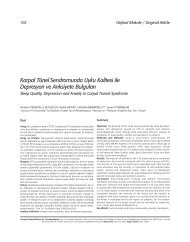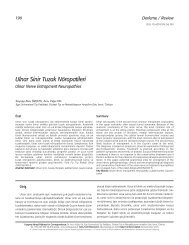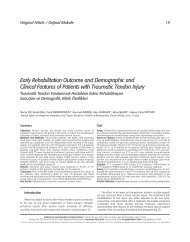‹nmeli Hastalarda Yaflflam Kalitesini Etkileyen ... - FTR Dergisi
‹nmeli Hastalarda Yaflflam Kalitesini Etkileyen ... - FTR Dergisi
‹nmeli Hastalarda Yaflflam Kalitesini Etkileyen ... - FTR Dergisi
You also want an ePaper? Increase the reach of your titles
YUMPU automatically turns print PDFs into web optimized ePapers that Google loves.
175<br />
23. Ulusal Fiziksel T›p ve Rehabilitasyon Kongresi / 23 rd National Physical Medicine & Rehabilitation Congress<br />
Türk Fiz Rehab Derg 2011:57Özel Say›; 1-334 /Turk J Phys Med Rehab 2011:57Suppl; 1-334<br />
P-042<br />
Kompleks Bölgesel A¤r› Sendromu Tip II’nin Efllik Etti¤i<br />
Karpal Tünel Sendromu<br />
Nilgün fiimflir Atalay 1, Nuray Akkaya 1, Selcen Alkan 2, Füsun fiahin 1<br />
1 Pamukkale Üniversitesi T›p Fakültesi Fizik Tedavi ve Rehabilitasyon Anabilim Dal›, Denizli<br />
2 Denizli Devlet Hastanesi Fizik Tedavi ve Rehabilitasyon Klini¤i, Denizli<br />
G‹R‹fi: Karpal tünel sendromu (KTS), median sinirin karpal tünel içinde s›k›flmas› sonucu, parmaklarda<br />
a¤r›, parestezi ve hipoestezi ile bulgu veren tuzak nöropatisidir. Karpal tünel<br />
gevfletme operasyonu yap›lan hastalarda kompleks bölgesel a¤r› sendromu (KBAS) geliflebildi¤ini<br />
bildiren yay›nlar olmas›na ra¤men, opere edilmemifl ve tedavi almam›fl KTS vakalar›nda<br />
KBAS komplikasyonu s›k bildirilen bir durum de¤ildir. Bu olgu sunumunda EMG’sinde ileri<br />
derecede KTS tan›s› alan hastam›zda operasyon öncesi saptanan KBAS klini¤i tan›mland›.<br />
OLGU: Otuz befl yafl›nda, kad›n hasta, yaklafl›k 2 ay önce bafllayan sa¤ el ilk 3 parmakta hissizlik,<br />
güçsüzlük, özellikle geceleri olan uyuflma ve bu flikayetlerden 3 hafta sonra bafllayan el<br />
bile¤inde fliddetli a¤r› yak›nmas› ile baflvurdu. Hastan›n öyküsünde tarlada çal›flma, elini afl›r›<br />
kullan›m mevcuttu. Muayenesinde elde ödem, s›cakl›k art›fl›, terleme, el bile¤i ve metakarpofalangeal<br />
(MKF) eklemlerde presyonla belirgin a¤r›s› vard›. Bafl parmak abduksiyonu kas gücü<br />
-4/5 de¤erinde olup çok a¤r›l› idi. Tinel, Phalen ve ters Phalen testlerinde pozitiflik mevcuttu.<br />
Görsel Analog Skalas› (GAS) ile hastan›n a¤r› fliddeti de¤erlendirildi¤inde GAS de¤eri 9<br />
idi. Hastan›n üst ekstremite dizabilitesini de¤erlendiren Disability of Arm, Shoulder and Hand<br />
Questionnaire kullan›ld›¤›nda de¤eri 75 idi. Yap›lan EMG’si ileri düzeyde KTS ile uyumlu idi. Çekilen<br />
Tc-99m MDP üç fazl› kemik sintigrafisinde görülen de¤ifliklikler KBAS lehine yorumland›.<br />
Laboratuvar incelemesi normaldi. Bu verilerle KBAS tan›s› konulan hastaya 3 hafta sürede<br />
azalt›larak kesilecek flekilde 30 mg prednizolon baflland›. Z›t banyo ve aktif eklem hareket<br />
aç›kl›¤› egzersizleri tarif edildi. Tedavi bitiminde hastan›n elindeki ödem, k›zar›kl›k, terleme<br />
bulgular› gerilemiflti. El bilek ve MKF eklemlerdeki presyonla GAS’› 1'di. Ancak parmaklardaki<br />
uyuflma, klinik testlerindeki pozitiflik halen devam ediyordu. Hastan›n a¤r›s› azald›ktan sonraki<br />
kas gücü -5/5 de¤erinde idi. EMG bulgular› da göz önünde tutularak hasta operasyona yönlendirildi.<br />
Operasyon sonras› hastan›n mevcut flikayetleri tamamen geriledi.<br />
SONUÇ: S›k rastlanan ve elektrofizyolojik testlerle kolayl›kla tan› konabilen KTS’ye efllik eden<br />
klinik bulgular varl›¤›nda KBAS tan›s›ndan flüphelenilmesi oluflabilecek deformitelerin önlenmesi<br />
aç›s›ndan önemlidir.<br />
Anahtar Kelimeler: Karpal tünel sendromu, kompleks bölgesel a¤r› sendromu, tedavi<br />
P-043<br />
Kum Torbas›na Yumruk Atma Sonras› Geliflen Kanat Skapula<br />
Nilgün fiimflir Atalay, Sibel Konukcu, Özlem Ercido¤an, Füsun fiahin<br />
Pamukkale Üniversitesi T›p Fakültesi Fizik Tedavi ve Rehabilitasyon Anabilim Dal›, Denizli<br />
G‹R‹fi: Kanat skapula (KS), skapulan›n medial kenar›n›n veya inferior aç›s›n›n gö¤üs<br />
duvar›ndan uzaklaflmas›d›r. KS, nörolojik hasarlanma, kemik veya periskapuler yumuflak dokudaki<br />
patolojik de¤iflikliklere ya da glenohumeral ve subakromial patolojilere ba¤l› olarak<br />
oluflabilir. Uzun torasik sinirin; direkt kompresyonu, tekrarlayan gerilme yaralanmalar›, künt<br />
travma, nevraljik brakial pleksus amyotrofi veya toraksa yönelik operasyonlarda hasar› serratus<br />
anterior kas›n›n güçsüzlü¤üne yol açarak kanat skapula ile sonuçlanabilir. Bu olguda kum<br />
torbas›na yumruk atma sonras› izole uzun torasik sinir hasar›na ba¤l› geliflen kanat skapula<br />
klini¤i tan›mlanm›flt›r.<br />
OLGU: Yirmi bir yafl›nda erkek, üniversite ö¤rencisi olan hasta, 4 ay önce oyun salonunda güç<br />
denemesi için kum torbas›na yumruk atma sonras›nda sa¤ omuzda fliddetli a¤r› flikayeti bafllam›fl.<br />
Bu flikayet ile bu sürede birçok hekime baflvuran hastaya omuz X-Ray ve manyetik rezonans<br />
görüntülemesi yap›lm›fl, sonuçlar› normal olarak belirtilerek kas zorlanmas› tan›s›yla<br />
NSA‹‹ ve miyorelaksan verilmifl, ancak flikayetleri tam olarak geçmeyince ortopedi taraf›ndan<br />
fizik tedavi amac›yla poliklini¤imize yönlendirilmiflti. Hastan›n muayenesinde inspeksiyonda<br />
sa¤da belirgin kanat skapulas› mevcuttu. Sa¤ üst ekstremite aktif ve pasif eklem hareketleri<br />
aç›k, a¤r›l›, serratus anterior kas gücü 1/5 iken di¤er kas güçleri tam, derin tendon refleksleri<br />
normoaktif, duyu defisiti yoktu. ‹mpingement testleri ve glenohumeral instabilite testlerinde<br />
özellik saptanmad›. Di¤er ekstremitelerin nörolojik muayeneleri normaldi. Hastan›n özgeçmiflinde<br />
özellik yoktu. Laboratuvar incelemesinde tam kan say›m›, sedimentasyon ve CRP normaldi.<br />
Hastan›n yap›lan EMG’sinde sa¤da serratus anterior kas›nda akut spontan aktiviteler<br />
(pozitif keskin dalga, fibrilasyon potansiyelleri), interferansta azalma saptand›. Di¤er incelenen<br />
kaslar ve üst ekstremite sinir iletim çal›flmalar› normaldi. Bu bulgularla uzun torasik sinirin<br />
k›smi subakut aksonal dejenerasyonu olarak raporland›. Bu verilerle fizik tedavi rehabilitasyon<br />
program›na al›nan hastaya omuz eklem hareket aç›kl›¤› ve serratus anteriora güçlendirme<br />
egzersizleri verildi. Hasta takibe al›nd›.<br />
SONUÇ: Farkl› tan›larla kar›flabilen ve gözden kaçabilen bu klinik patolojinin nedenlerinin<br />
ortaya konmas› olusabilecek komplikasyonlar›n önlenmesi aç›s›ndan çok önemlidir.<br />
Anahtar Kelimeler: Kanat skapula, uzun torasik sinir, periferik sinir yaralanmas›<br />
P-042<br />
Carpal Tunnel Syndrome Accompanied with Complex Regional Pain<br />
Syndrome Type II<br />
Nilgün fiimflir Atalay1, Nuray Akkaya1, Selcen Alkan2, Füsun fiahin1 1Pamukkale University Medical School Department of<br />
Physical Medicine and Rehabilitation, Denizli<br />
2Denizli Government Hospital, Physical Medicine and Rehabilitation Clinic, Denizli<br />
INTRODUCTION: Carpal tunnel syndrome (CTS) is an entrapment neuropathy with pain in the<br />
fingers, paresthesia and hypoesthesia as a result of the compression of the median nerve.<br />
Although there are publications stating that carpal tunnel relaxation surgery can cause complex<br />
regional pain syndrome (CRPS), CRPS complication is rare in patients who are not treated<br />
or not operated for CTS. In this case presentation, CRPS was clinically determined before<br />
the operation in a patient diagnosed as advanced carpal tunnel syndrome on electrodiagnostic<br />
investigation.<br />
CASE: Thirty-five year-old female patient applied with weakness, numbness in first 3 fingers<br />
of right hand, especially at night, starting approximately 2 months ago, and severe pain on<br />
right wrist 3 weeks after the onset of the symptoms. Patient’s history showed agricultural<br />
work and extreme uses of hand. On the examination, edema on the hand, increased heat,<br />
sweating, pain with pressure on wrist and metacarpophalangeal (MCP) joints were found.<br />
Thumb abduction muscle strength was -4/5 and painful. Tinnel, Phalen and Reverse Phalen<br />
tests showed positive results. Visual Analogue Scale (VAS) was 9 in severity of pain. In evaluating<br />
disability of the patient's upper limb, Disability of Arm, Shoulder and Hand<br />
Questionnaire was used, and the score was found 75. EMG showed positive correlation with<br />
advanced CTS. Three-phased bone scintigraphy with Tc-99m MDP results were interpreted<br />
as CRPS. Laboratory tests were normal. Prednisolon starting from 30 mg was given to the<br />
patient, stopped at the end of the third week by decremental dose regimen with the diagnosis<br />
of CRPS. Contrast bath and active range of motion exercises were explained to the<br />
patient.. At the end of the treatment, edema of the hand, redness and sweating symptoms<br />
had decreased. Wrist and MCP joint VAS score with pressure were one. Numbness in fingers<br />
and positive results of clinical tests have still continued. Her muscle strength was -5/5 after<br />
the relief of pain. Patient was advised for operation according to EMG results. All complaints<br />
regressed completely after the surgery.<br />
CONCLUSIONS: Suspecting of CRPS accompanied to CTS, which is generally seen and<br />
can be easily diagnosed with electrophysiological tests, can reduce or prevent possible<br />
deformities<br />
Keywords: Carpal tunnel syndrome, complex regional pain syndrome, treatment<br />
P-043<br />
Winged Scapula which Occurred After Punching a Sand Bag<br />
Nilgün fiimflir Atalay, Sibel Konukcu, Özlem Ercido¤an, Füsun fiahin<br />
Pamukkale University Medical School Department of Physical<br />
Medicine and Rehabilitation, Denizli<br />
INTRODUCTION: Winged scapula (WS) is moving away of scapula’s medial border or inferior<br />
angle from thorax wall. WS can be caused by neurological trauma, pathological changes in<br />
bone or pericapsular soft tissue or glenohumeral and subacromial pathologies. Direct compression<br />
to the long thoracic nerve, repeated tensile trauma, blunt trauma, neuralgic brachial<br />
plexus amyotrophy or surgeries on thorax can lead to the weakness in the serratus anterior<br />
muscle, thus resulting in WS. In this case, WS clinical manifestation due to the isolated long<br />
thoracic nerve damage after punching the sandbag was explained.<br />
CASE: Twenty-one year old male patient, university student presented with the complaint of<br />
severe pain in right shoulder which began after punching a sandbag 4 months ago in the<br />
gym. Consulting to many physicians because of this pain, his X-ray and magnetic resonance<br />
imagining the results were normal and he was diagnosed as muscle strain thus NSAID and<br />
myorelaxatings were given. His pain did not decrease. He consulted orthopedics from where<br />
he was referred to our clinic. His physical examination determined visible winged scapula on<br />
the right. Right upper limb active and passive range of motion were normal but with pain.<br />
Serratus anterior muscle strength was 1/5 whereas other muscle strengths were normal,<br />
deep tendon reflexes were normoactive, sensory deficit was not determined. Pathologic findings<br />
were not detected in the impingement tests and glenohumeral instability tests.<br />
Neurological examinations of other extremities were normal. The patient had no other feature<br />
in history. In laboratory tests, complete blood count, sedimentation rate and CRP were<br />
normal. EMG showed acute spontaneous activities (positive sharp wave, fibrillation potentials)<br />
and decrease in interference on right serratus anterior muscle. Other investigated muscles<br />
and upper limb nerve conduction tests were normal. With these findings, subacute partial<br />
axonal degeneration of the long thoracic nerve was reported. A rehabilitation program<br />
consisting of shoulder joint range of motion and serratus anterior strengthening exercises<br />
were given to the patient. The patient was being followed up.<br />
CONCLUSIONS: Finding out the causes of this clinical pathology which can be missed or confused<br />
with other diagnosis has critical importance to avoid complications.<br />
Keywords: Winged scapula, long thoracic nerve, peripheric nerve injury


